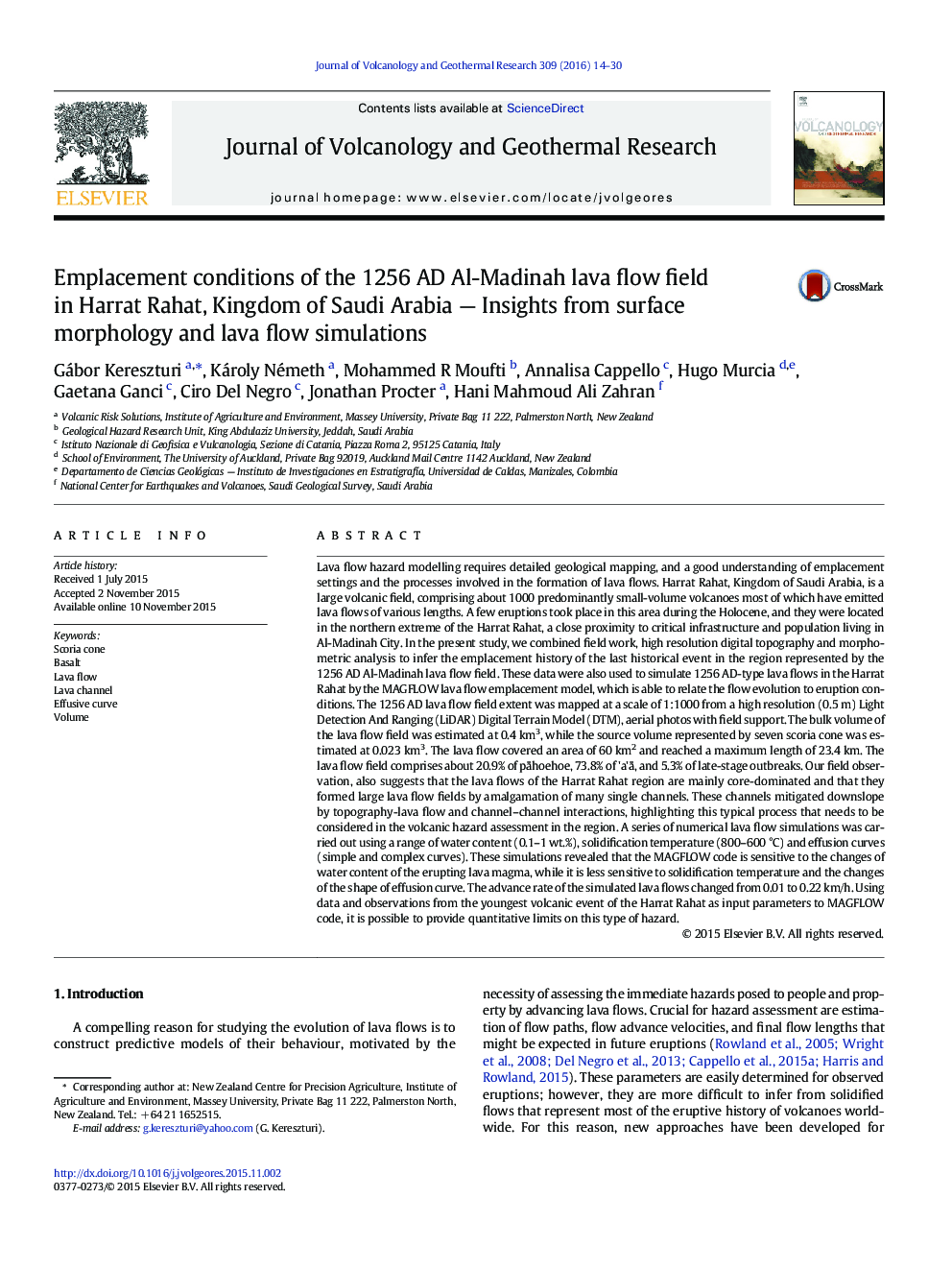| کد مقاله | کد نشریه | سال انتشار | مقاله انگلیسی | نسخه تمام متن |
|---|---|---|---|---|
| 4714302 | 1638313 | 2016 | 17 صفحه PDF | دانلود رایگان |

• Morphometric analysis of a basaltic lava flow is carried out using high-resolution Light Detection and Ranging (LiDAR).
• Volumes of scoria cones and the lava flow field are estimated from a Digital Terrain Model.
• An effusive scenario is created using the 1256 AD Al-Madinah lava flow field.
• Lava flow simulations are least affected by changing solidification temperature from 800 to 600 °C.
• The largest impact on lava flow simulation results with MAGFLOW is due to changing water content.
Lava flow hazard modelling requires detailed geological mapping, and a good understanding of emplacement settings and the processes involved in the formation of lava flows. Harrat Rahat, Kingdom of Saudi Arabia, is a large volcanic field, comprising about 1000 predominantly small-volume volcanoes most of which have emitted lava flows of various lengths. A few eruptions took place in this area during the Holocene, and they were located in the northern extreme of the Harrat Rahat, a close proximity to critical infrastructure and population living in Al-Madinah City. In the present study, we combined field work, high resolution digital topography and morphometric analysis to infer the emplacement history of the last historical event in the region represented by the 1256 AD Al-Madinah lava flow field. These data were also used to simulate 1256 AD-type lava flows in the Harrat Rahat by the MAGFLOW lava flow emplacement model, which is able to relate the flow evolution to eruption conditions. The 1256 AD lava flow field extent was mapped at a scale of 1:1000 from a high resolution (0.5 m) Light Detection And Ranging (LiDAR) Digital Terrain Model (DTM), aerial photos with field support. The bulk volume of the lava flow field was estimated at 0.4 km3, while the source volume represented by seven scoria cone was estimated at 0.023 km3. The lava flow covered an area of 60 km2 and reached a maximum length of 23.4 km. The lava flow field comprises about 20.9% of pāhoehoe, 73.8% of 'a'ā, and 5.3% of late-stage outbreaks. Our field observation, also suggests that the lava flows of the Harrat Rahat region are mainly core-dominated and that they formed large lava flow fields by amalgamation of many single channels. These channels mitigated downslope by topography-lava flow and channel–channel interactions, highlighting this typical process that needs to be considered in the volcanic hazard assessment in the region. A series of numerical lava flow simulations was carried out using a range of water content (0.1–1 wt.%), solidification temperature (800–600 °C) and effusion curves (simple and complex curves). These simulations revealed that the MAGFLOW code is sensitive to the changes of water content of the erupting lava magma, while it is less sensitive to solidification temperature and the changes of the shape of effusion curve. The advance rate of the simulated lava flows changed from 0.01 to 0.22 km/h. Using data and observations from the youngest volcanic event of the Harrat Rahat as input parameters to MAGFLOW code, it is possible to provide quantitative limits on this type of hazard.
Figure optionsDownload as PowerPoint slide
Journal: Journal of Volcanology and Geothermal Research - Volume 309, 1 January 2016, Pages 14–30